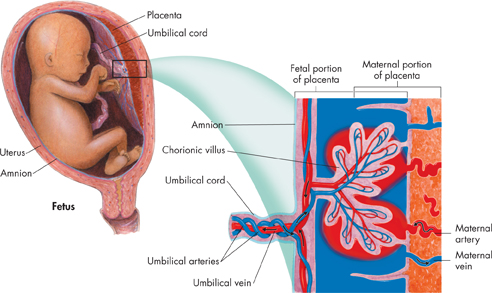
FIGURE 34–22 The Placenta The connection between the mother and the developing embryo or fetus is called the placenta. It is through the placenta that the embryo gets its oxygen and nutrients and excretes wastes. Notice how the chorionic villi from the fetus extend into the mother's uterine lining (indicated by the overlapping brackets). Infer Does carbon dioxide from the fetus travel through the umbilical arteries or umbilical vein?
dThe Placenta As the embryo develops, specialized membranes form to protect and nourish the embryo. The embryo is surrounded by the amnion, a sac filled with amniotic fluid that cushions and protects the developing embryo. Another sac, known as the chorion, forms just outside the amnion. The chorion makes direct contact with the tissues of the uterus. Near the end of the third week of development, small, fingerlike projections called chorionic villi form on the outer surface of the chorion and extend into the uterine lining.
The chorionic villi and uterine lining form a vital organ called the placenta. The placenta is the connection between the mother and embryo that acts as the embryo's organ of respiration, nourishment, and excretion. Across this thin barrier, oxygen and nutrients diffuse from the mother's blood to the embryo's blood; carbon dioxide and metabolic wastes diffuse from the embryo's blood to the mother's blood.
The blood of the mother and that of the embryo flow past each other, but they do not mix. The exchange of gases and other substances occurs in the chorionic villi. Figure 34–22 shows a portion of the placenta. The umbilical cord, which contains two arteries and one vein, connects the embryo to the placenta.
After eight weeks of development, the embryo is called a fetus. By the end of three months of development, most of the major organs and tissues of the fetus are fully formed. The fetus may begin to move and show signs of reflexes. The fetus is about 8 centimeters long and has a mass of about 28 grams.
 In Your Notebook Explain in your own words the role of the placenta in human development.
In Your Notebook Explain in your own words the role of the placenta in human development.
Table of Contents
- Formulas and Equations
- Applying Formulas and Equations
- Mean, Median, and Mode
- Estimation
- Using Measurements in Calculations
- Effects of Measurement Errors
- Accuracy
- Precision
- Comparing Accuracy and Precision
- Significant Figures
- Calculating With Significant Figures
- Scientific Notation
- Calculating With Scientific Notation
- Dimensional Analysis
- Applying Dimensional Analysis




